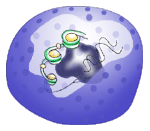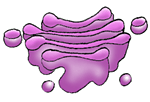
Parts of a cell and their Functions
 Plasma membrane- The membrane enclosing a cell is made up of two lipid layers called a "bilipid" membrane. The lipids that are present in the plasma membrane are called "phospholipids."
Plasma membrane- The membrane enclosing a cell is made up of two lipid layers called a "bilipid" membrane. The lipids that are present in the plasma membrane are called "phospholipids."
These lipid layers are made up of a number of fatty acid building blocks. The fatty acid that makes up this membrane has two different parts to it- a small water loving head- hydrophilic head. Hydro stands for water and philic means liking or loving. The other part of this fatty acid is a long water-repelling or water hating tail.
This tail is hydrophobic- Hydro stands for water and phobic means fear. The plasma membrane is arranged in such a way so that the tails face each other on the inside and the heads face towards the outside of the membrane.
Channels/pores- A channel in the cell's plasma membrane. This channel is made up of certain proteins that control the movement of molecules, including food and water, into the cell.
Nucleus- The nucleus is the control center of the cell. It is the largest organelle in the cell and it contains the DNA of the cell.
 Inside the nucleus is another organelle called the nucleolus. The nucleolus is responsible for making ribosomes.
Inside the nucleus is another organelle called the nucleolus. The nucleolus is responsible for making ribosomes.
The circles on the surface of the nucleus are the nuclear pores. These are where ribosomes, and other materials move in and out of the cell.
Endoplasmic reticulum (ER)- It is a network of membranes throughout the cytoplasm of the cell. There are two types of ER.
When ribosomes are attached it is called rough ER and smooth ER when there are no ribosomes attached.
The rough endoplasmic reticulum is where most protein synthesis occurs in the cell. The function of the smooth endoplasmic reticulum is to synthesize lipids in the cell. The smooth ER also helps in the detoxification of harmful substances in the cell.

Ribosomes- Organelles that help in the synthesis of proteins. Ribosomes are made up of two parts, called subunits.
They get their names from their size. One unit is larger than the other so they are called large and small subunits.
Both these subunits are necessary for protein synthesis in the cell. When the two units are docked together with a special information unit called messenger RNA, they make proteins.
Some ribosomes are found in the cytoplasm, but most are attached to the endoplasmic reticulum. While attached to the ER, ribosomes make proteins that the cell needs and also ones to be exported from the cell for work elsewhere in the body.
Golgi complex- It is the organelle in the cell that is responsible for sorting and correctly shipping the proteins produced in the ER. Just like our postal packages, which should have a correct shipping address, the proteins produced in the ER should be correctly sent to their respective address. It is a very important step in protein synthesis. If the Golgi complex makes a mistake in shipping the proteins to the right address, certain functions in the cell may stop.
 This organelle was named after an Italian physician-Camillo Golgi. He was the first person to describe this organelle in the cell. It is also the only organelle that is capitalized.
This organelle was named after an Italian physician-Camillo Golgi. He was the first person to describe this organelle in the cell. It is also the only organelle that is capitalized.
Mitochondrion- This is the cell’s powerhouse. This organelle packages the energy from the food you eat into ATP molecules.
Every type of cell has a different amount of mitochondria (plural). There are more mitochondria in cells that have to perform lots of work, for example- your leg muscle cells, heart muscle cells etc. Other cells need less energy to do their work and have less mitochondria.
Chloroplast- This is the organelle in which photosynthesis takes place. In this organelle the light energy of the sun is converted into chemical energy.
Chloroplasts are found only in plant cells not animal cells. The chemical energy that is produced by chloroplasts is finally used to make carbohydrates like starch that get stored in the plant.
Chloroplasts contain tiny pigments called chlorophylls. Chlorophylls are responsible for trapping the light energy from the sun.







